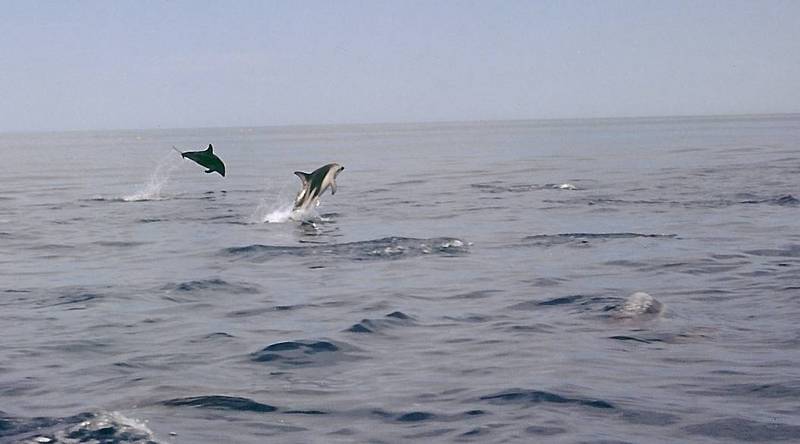|
Dusky Dolphin (Lagenorhynchus obscurus) - Wiki
| 제목: | Dusky Dolphin (Lagenorhynchus obscurus) - Wiki
| |

| 해상도: 1054x585
파일크기: 57150 Bytes
등록시간: 2007:09:24 04:36:39
|
Dusky Dolphin
From Wikipedia, the free encyclopedia
[Photo] Dusky Dolphins (Lagenorhynchus obscurus) photographed by Mirko Thiessen (Baldhur) off Kaikoura, New Zealand, February 1992. Fotograf: Mirko Thiessen (http://en.wikipedia.org/wiki/User:Baldhur). Ort: Neuseeland, S??dinsel, Februar 1992. Copyright (C) Mirko Thiessen
Permission is granted to copy, distribute and/or modify this document under the terms of the GNU Free Documentation License, Version 1.2 or any later version published by the Free Software Foundation; with no Invariant Sections, no Front-Cover Texts, and no Back-Cover Texts. A copy of the license is included in the section entitled "GNU Free Documentation License". |
The Dusky Dolphin (Lagenorhynchus obscurus) is a highly gregarious and acrobatic dolphin found in coastal waters in the Southern Hemisphere. It was first identified by John Edward Gray in 1828. It is very closely genetically related to the Pacific White-sided Dolphin, but current scientific consensus is that they are distinct species.
Though the Dusky and Pacific White-sided Dolphins are traditionally placed in the genus Lagenorhynchus, recent molecular analyses indicate that they are more closely related to the dolphins of the genus Cephalorhynchus. If true, this would mean that these two species must either be transferred to Cephalorhynchus or be given a new genus of their own.
Physical description
The Dusky Dolphin is short to medium in length in comparison with other species in the family. There is significant variation in size among the different population areas. The largest Duskies have been encountered off Peru, where they are up to 210 cm in length and 100 kg in weight. The back of the dolphin is dark grey and dorsal fin is distinctively two-toned???the leading edge matches the back in colour, but the trailing edge is a much lighter greyish white. Duskies have a long, light grey patch on their foreside leading to a short, dark grey beak. The throat and belly are white. There are two blazes of white colour running back on the body from the dorsal fin to the tail. Dusky Dolphins may easily be confused with Peale's Dolphins when observed at sea.
Population and distribution
The population of Dusky Dolphins is unknown, but authorities do not fear for the survival of the species at the moment. The Dusky Dolphin is distributed in coastal waters of Chile, Argentina and the Falkland Islands, Namibia and the west coast of South Africa and all around New Zealand. There may also be resident populations off Tasmania and New South Wales and several small islands in the South Atlantic and Indian Oceans. An aerial survey off Patagonia in the mid-1990s indicated that there was a local population in excess of 7,000 individuals. Duskies can move over great distances (one individual had a confirmed range of 780 nautical miles) (1,440 km). However it is not believed that they follow a migatory pattern.
Conservation and dolphin-watching
Outside Peruvian coastal waters, the main danger to Dusky Dolphins from humans is the accidental catching of individuals by fishing trawls. In the mid-1980s around 400???600 animals were killed annually off Patagonia due to individuals becoming trapped in nets. Rates appear to have declined since then, due to tighter regulations on the fishing industry. However, in Peruvian waters, in addition to accidental catches, there is continuing deliberate catching via nets and harpoons. The number of animals killed each year in this area runs into the thousands and is a cause of concern for conservationists.
On account of their highly acrobatic displays and movements in large groups called pods, Dusky Dolphins are firm favourites with dolphin-watching enthusiasts. Several boat operators from Kaikoura, on New Zealand South Island are either dedicated to watching Duskies or watch them in combination with tours aimed at watching Sperm Whales.
http://en.wikipedia.org/wiki/Dusky_Dolphin
| The text in this page is based on the copyrighted Wikipedia article shown in above URL. It is used under the GNU Free Documentation License. You may redistribute it, verbatim or modified, providing that you comply with the terms of the GFDL. |
|
^o^
동물그림창고 똑똑전화 누리집
^o^
|
|